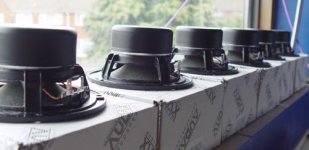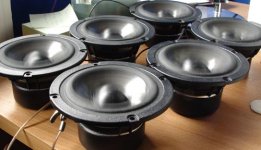hi, just a quick question here, if I want to drop the sensitivity of the tweeter down so that it matches the mids, can I just string a resistor of the appropriate value in series with the driver?
What I want to do here is to drop the tweeter down four dB, so I figure, for a four ohm driver I will need a 2.34 (2.22) ohm resistor in series with the driver (as 20log(4/6.22) = -3.8dB), right?
What I want to do here is to drop the tweeter down four dB, so I figure, for a four ohm driver I will need a 2.34 (2.22) ohm resistor in series with the driver (as 20log(4/6.22) = -3.8dB), right?
Hey there!bigparsnip said:hi, just a quick question here, if I want to drop the sensitivity of the tweeter down so that it matches the mids, can I just string a resistor of the appropriate value in series with the driver?
What I want to do here is to drop the tweeter down four dB, so I figure, for a four ohm driver I will need a 2.34 (2.22) ohm resistor in series with the driver (as 20log(4/6.22) = -3.8dB), right?
Impressive that some people actually do the maths of this stuff, when there are plenty of online calculators and examples. I'm lazy, nuff said 😀
Anyway, that sounds about right to me, but I'd just like to add, the 'correct' tweeter attenuation might not be to your liking. Depending on many factors, you may prefer more or less top end coming through, so try a smaller one and a larger one too when listening. Sorry if I'm stating the obvious, I don't mean to patronise.
Your alternative is to use one in parallel too (the commonly used 'L-pad' circuit), but as some claim this dulls the sound why bother with an extra resistor? (Mine only has one in series)
Anyway, I just wanna say experiment, muck around, who cares what's 'right' or 'wrong' 😀
bigparsnip said:hi, just a quick question here, if I want to drop the sensitivity of the tweeter down so that it matches the mids, can I just string a resistor of the appropriate value in series with the driver?
What I want to do here is to drop the tweeter down four dB, so I figure, for a four ohm driver I will need a 2.34 (2.22) ohm resistor in series with the driver (as 20log(4/6.22) = -3.8dB), right?
If the tweeter does not have a Fs impedance rise yes.
If it does a series / parallel resistor combination is better.
🙂 sreten.
right, well in that case I'll get a few in and give it a bash next week (I may even see if i can find another cardboard box 😀 ) with the crossover components I ordered today (only first order at about 3200Hz, but I thought I would start simple for my first try, and I can alwas change it if I don't like the sound)
pinkmouse said:
Exactly, sorry if I offended
No, not at all. Sorry if I sound stupid, im dont know very much really, and if I dont know something, I just ask about it.
Well I've now done 50 hours break-in for all drivers, and they still need more. The second batch were run-in at mechanical excursion (or what I thought to be) and the first batch was run-in at a more conservative level (xmax-ish). There is a measured difference between batches, so I will run them all in some more (at mechanical exc.), something I was afraid to do considering the 30W rating.
This just shows me how much run-in time speakers need (or maybe just these ones). I think it would take a long time to completely break these drivers in with music content.
Seems that your measurements could be ok pinkmouse, depending on how long and how hard you ran these little things in for.
This just shows me how much run-in time speakers need (or maybe just these ones). I think it would take a long time to completely break these drivers in with music content.
Seems that your measurements could be ok pinkmouse, depending on how long and how hard you ran these little things in for.
Attachments
SimontY said:Highly cool! 😎 😎
I agree!
I remember some1 doing a similar thing with an XLS driver as you can imagine lots of movement.
I wouldnt worry to much about exceeding the power ratings with low frequency sine waves. Typicallly you will require less then 1 watt at about 20-30hz to exceed xmax in free air.
These are the final measured specs after 70 hours break-in.
Fs: 79.6
Vas: 2.85
Qms: 2.63
Qes: 0.81
Qts: 0.62
Le: 0.16
The parameters are acceptably in spec (within 30% of Audax specs except for Vas), but more importantly they are quite consistent with each other. Nevertheless, accept them at your own risk.
The specs are derived from the average over six drivers. For those interested, I've put the individual driver measurements from each break-in period on my site. This was a little project in itself, and quite interesting to see how parameters change.
Time to start designing...
Fs: 79.6
Vas: 2.85
Qms: 2.63
Qes: 0.81
Qts: 0.62
Le: 0.16
The parameters are acceptably in spec (within 30% of Audax specs except for Vas), but more importantly they are quite consistent with each other. Nevertheless, accept them at your own risk.

The specs are derived from the average over six drivers. For those interested, I've put the individual driver measurements from each break-in period on my site. This was a little project in itself, and quite interesting to see how parameters change.
Time to start designing...
My four will be finishing 50hrs run in tonight. I will post my results as a comparison.
BTW, I use 12.5 Hz, ( 'cos it's quiet), cycling to Xmax. About 1.8V in free air.
BTW, I use 12.5 Hz, ( 'cos it's quiet), cycling to Xmax. About 1.8V in free air.
i guess it doesnt move in and out as often as it would at a higher frequency. Suppose it depends on what matters most, time being run or number of oscillations...
Steve
Steve
I think its better to do at low frequency. The aim is to stretch out and settle the suspension and surround and this is done with big movements. The lower the frequency used, the less power required and more movement you get. I'd prefer not to run the drivers at a higher frequency for long periods at high levels of excursion, although I guess they would run in quicker.
Look forward to your results PM.
Look forward to your results PM.
Vikash
I would be interested in your thoughts as to what tweeters you are considering.
I have pretty much given up trying to obtain the "F1" from Audax.
And thank-you for carrying out the tests and sharing your findings with us all.
I really like the look and feel of your website by the way, very nice....
m
I would be interested in your thoughts as to what tweeters you are considering.
I have pretty much given up trying to obtain the "F1" from Audax.
And thank-you for carrying out the tests and sharing your findings with us all.
I really like the look and feel of your website by the way, very nice....
m
I have no idea what tweeter I'm going to use. My criteria is simply that it should keep in line with the awesome saving on the AP100Z0 (so cheep then 😀 ). I was considering the TM025F1 too, but I can only find 1 in the three branches I've tried.
After speaking with someone at the local Maplins, he said that they're phasing out all the Audax line (which we aleady know) and they will be replaced with Macs Power (or somthing like that). No, I haven't heard of them either, and was informed they will be of lesser class.
Also, they apparently know when and what drivers are on close-out special but he can't divulge that information to the public.
Anyway, I've set myself a max budget of £15 per tweeter, so if anyone has any suggestions...
After speaking with someone at the local Maplins, he said that they're phasing out all the Audax line (which we aleady know) and they will be replaced with Macs Power (or somthing like that). No, I haven't heard of them either, and was informed they will be of lesser class.
Also, they apparently know when and what drivers are on close-out special but he can't divulge that information to the public.
Anyway, I've set myself a max budget of £15 per tweeter, so if anyone has any suggestions...
Im using TW025A0. They were about £12.50 I think. This was more by blindly picking them out at random rather than by design, so I hope they're ok! hehe
Steve
Steve
UZ07H & UZ03D now reduced to £7.98 from £12.99 & £10.99 at maplins! Both 5 1/4" drivers. MY22Y 34mm tweet also was £24.99 now £14.98
cheers steve
cheers steve
Now we're talking 😎MY22Y 34mm tweet also was £24.99 now £14.98
The model number is TW034X0 and is part of their "high quality" range (the AP100Z0 is part of the standard range).
PM, Dave, Matt, any opinions/experience with this tweeter?
An externally hosted image should be here but it was not working when we last tested it.
- Status
- Not open for further replies.
- Home
- Loudspeakers
- Multi-Way
- Maplins close-out on AP100Z0

